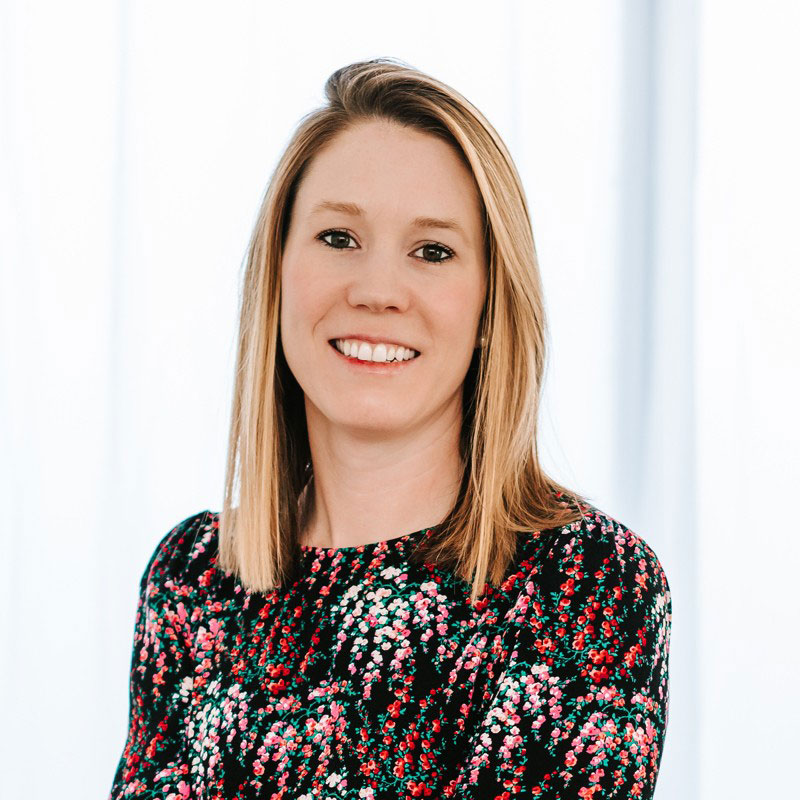Double the Pace of Innovation: Building a Strategy Execution Program
Transcript from Accelerate 2023
We’re delighted to introduce our next speaker, Summers Hutchings. Summers is the Director of Product Delivery and Portfolio Strategy at CarMax. She joined CarMax in 2018 and led the corporate strategy team for two years before transitioning to CarMax’s digital product organization in 2021, where she currently leads Product Delivery and Portfolio Management. Prior to CarMax, she spent a few years at Deloitte in their strategy and operations practice. Fun fact about Summers: On Sunday, she ran a half Iron Man – or not just ran... you run, swim, bike, you do it all – and came in third place. I mean, that’s pretty cool. So, without further ado, welcome, Summers.
Summers Hutchings, Director of Product Delivery & Portfolio Management at CarMax: Thank you so much for having me. I was just texting my husband a little bit earlier and said, I feel seen at this conference. And he was like, what do you mean? And I was like, it’s all the people that think like me. This is awesome! You’ll hear a little bit more about my story and our journey that we’ve been through. We have a lot more on our journey to feel really good about our program. I came from corporate strategy and my boss, who’s now our Chief Product Officer, continues to think like a strategist, and he is a strategist. And so, I’ve had to really figure out and leverage a lot of the folks in the room here from CarMax on how to really translate higher order strategy into actual team level strategy and how to actually bring that to life.
I’m going share a little bit more about that journey today. One of the things that our Chief Product Officer now has said over and over again is, “I want to double the pace of innovation. We want to go faster and faster and faster.” So, you’ll see some of that as a theme throughout. And how do we go faster and how do we execute our goals in a bigger way?
I’ve been with CarMax for about six years. I felt like I was a strategist until I’ve been in this role now for three years, and like I said, I’ve been seen. I actually feel like this might be my calling. It’s been really fun to figure out how to take all the things I learned as a strategist and in my role as a consultant and in corporate strategy, and then figure out how to really bring that to life in a really, for us, pretty big org.
I want to double the pace of innovation. We want to go faster and faster and faster.”
Our Starting Point
Without further ado, what I want to talk through today is just our starting point. I think most of you know CarMax as a used car dealer. When I started at CarMax, I sat in one of our product open houses and I thought, I don’t work for a used car company. I work for a technology company that happens to sell used cars. So, I want to help you understand a little bit more about what that looked like for us, and what my starting point was as I took on this role in product delivery operations and portfolio management. Then I’ll talk through where we’ve kind of landed or where we are today in our journey and how we’ve set up our program. It has been an evolution. It’ll continue to be an evolution.
Then I’ll finish up my session with just what my thoughts are on where we’ll look ahead over the next couple of years and continue to refine our strategy and execution. We actually do consider ourselves the original disruptor in used cars. What’s interesting is when we say we disrupted, it was really disrupting on values. We really believed in the value of no haggle. We put one price on all our cars and really wanted to preach and share this value of honesty and transparency in every interaction in every transaction. This made us very successful for 15-20 years. But most of our growth though, happened via store growth. So, we were known as operators and executors.
If you put a goal in front of us, we’d weather the environment and figure out how to continue to grow coming out of that. We were kind of innovators in our own right, at the time. So, in the mid 2015 to 2018 timeframe, we were really starting to feel the pressure of all these consumers who really saw what Target, Walmart, and Amazon were doing and wanted to do more and more on their own or more and more online. We also had some big competitive threats, like Carvana. We really needed to figure out how to digitally transform and enable our customers to be able to shop the way they wanted.
“We have to accelerate our vision, accelerate our strategy, and really bring digital across all our business areas and shopping and selling experiences.”
That’s where I joined CarMax. We just set out on that journey to try to digitally transform. So, when I talk about our transformation, that’s really around our digital transformation and moving from a very human centric, people-oriented process in buying and selling a car to a more digitally enabled process. In 2018, our goal unanimously was getting to a hundred percent omni-channel. We wanted to build and roll out this omni-channel experience. We knew it would be a multi-year endeavor. I was in corporate strategy, and we actually interviewed a lot of executives to get a sense of where we were on our strategy and to better understand where we wanted to go from there. And unanimously, every single one of those executives, when we asked what the number one goal is right now, they said omni, which was pretty incredible.
From a strategy standpoint, it was amazing. But then as we were coming through the pandemic, about six months in, we had rolled out our omni-channel endeavor and we had a lot of people who were at home wanting to shop for cars, buy cars, that didn’t want to come into the store. I said, we have to accelerate our vision, accelerate our strategy, and really bring digital across all our business areas and shopping and selling experiences. This is when we started this mantra: We need to double the pace of innovation. In corporate strategy, what that felt like was, we needed to make some really great slides and frameworks, and we need to share them with a lot of different people, and then they’re going to go off and running. It’s going to be great!
Then, I had a product manager ask, “What is the conversation going to be like for this specific thing? What should we be going after?” I said, I had no idea, but the strategy is this and that’s all you need to know. So, it was definitely clear that we needed to break down further what our strategy was, what our goals were. Our pretty slides didn’t need to exist, we just needed to gain and generate some alignment. We got to a point where we had six different pillars and priorities that we were working against. We had created a foundational thing, and it was created, but what was going to drive us towards this overarching thing?
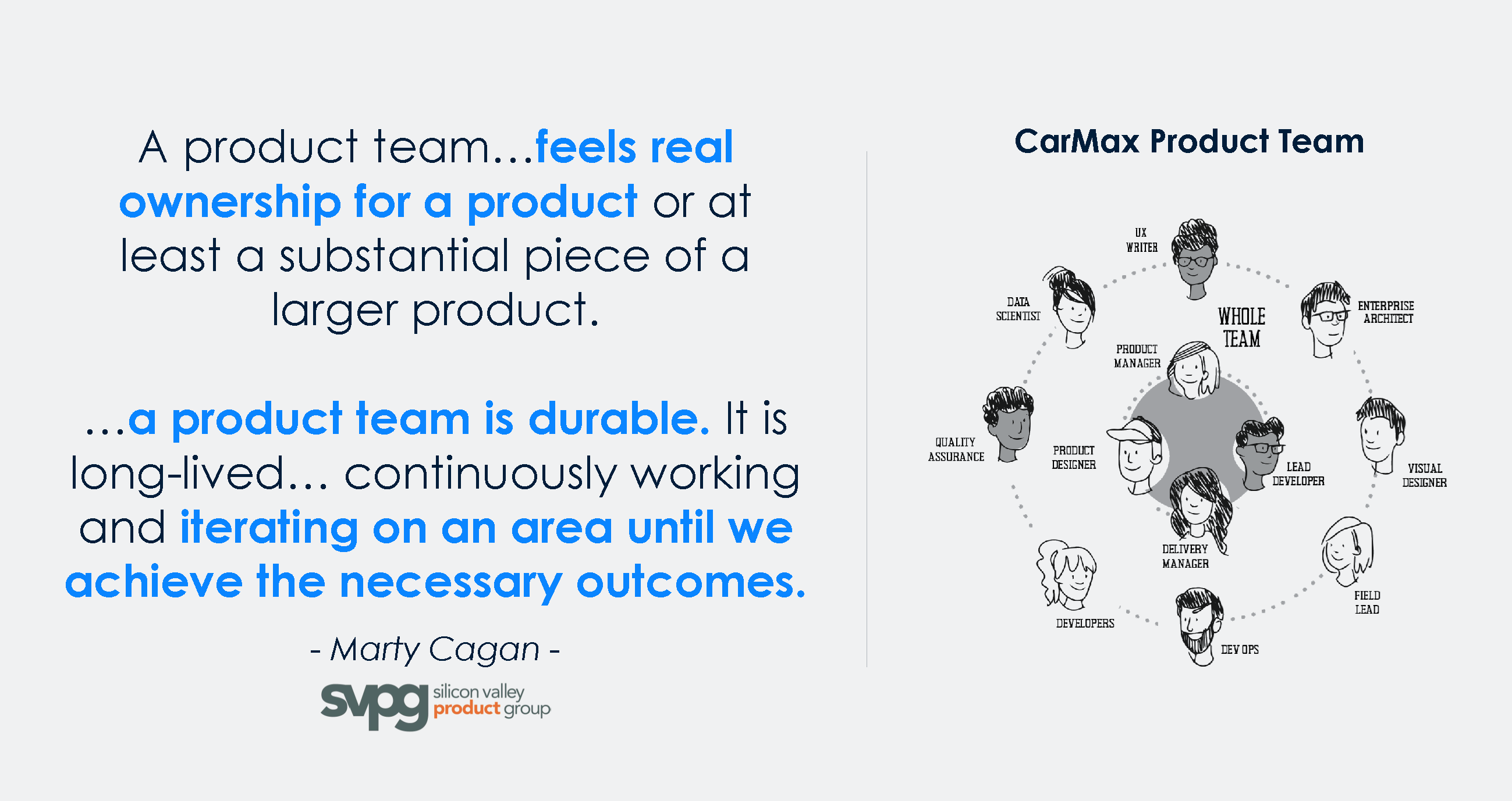
Product Org Alignment
We needed to make sure we had everyone working against those. But then each one of those had multiple different bodies of work and multiple different priorities, and it just got crazy. We had a lot of different priorities. And one of the things that we had to do in tandem with this was grow our digital product org. We had launched a product org with 5 to 10 teams at the time, and we were focused on omnichannel and our upper funnel experiences. However, we were nowhere near where we needed to be in order to deliver on all of this effectively.
I want to pause for a minute and help you understand a little bit more about what our Digital Product org looked like, because it does have a big implication for how we had to think about the integration with WorkBoard and how we had to think about our planning and execution. There was already a philosophy and already some principles that our product organization was working from, which was phenomenal, but it did create some challenges for us.
Our Product teams are modeled after Marty Kagan and the Silicon Valley product group. They’re highly cross-functional, meaning each member of the team reports up through a different chain. It’s very matrixed, and these teams are enduring, so they’re not put together just for a single project. And then they disband, like they’re really working together day in, day out for months, quarters, or sometimes years depending on the mission of the team. They’re mission driven and OKRs were a big part of the culture. There was a sentiment that we were going to iterate our way to what our goals were and our strategy, which again, great principles that we want to continue to live by, but we needed to put a little bit more around how do we plan to get to what our goals are.
Marty Kagan described that durable is iterating on an area until we achieve the necessary outcomes. So, the makeup of the team included the product manager, lead developer, and designers. The makeup of that core team is surrounded by a larger team including all of the engineers and delivery managers. The role is really the intersection of program management, project management, and scrum and agile practices. It is an integral role to scaling our org. And what I was finding as I was stepping into this role was, we were doing a great job of managing these teams. We were even doing a great job of managing across a few different teams, but what we were missing was: What is this overarching operating model for ourselves?
Through this timeframe, we had grown this Product org pretty dramatically. And for every one of those teams, there’s about 10 to 12 people as part of those teams or managing those teams. So, we went from roughly 50 people to 800 people. When you think about management, we had a lot of challenges. As I walked into this, I will admit, I had no idea what I was exactly stepping into, but here’s some of the problems that we were working through.
“Our product teams are modeled after Marty Kagan and the Silicon Valley product group. They’re highly cross-functional, meaning each member of the team reports up through a different chain.”
Product Org Challenges
One: There wasn’t any more low hanging fruit. We had already addressed some of the harder challenges and problems that an individual team could independently solve. We were dealing with more complexity in terms of what we were trying to work towards.
Second, we had a new layer of leaders. So, as we were scaling dramatically, we had more leaders who were first time leaders, new to CarMax, or new to the product methodology. It was like the blind leading the blind on various aspects, and everyone had their own flavor of what good looked like. It was really challenging to know what the right answer was, or what good looks like.
The third thing here was just challenging associate engagement. We were operating in more of a remote environment, like many organizations, and our associates were feeling more siloed or not as connected to their peers. We had massive communication and collaboration pain points. For example, this team either had a strategic dependency on another team, and they needed to be thinking about the customer or the associate that is the user of their experience together, or there were some technical dependencies. So, they needed that team to actually do some work to enable them to meet their goals.
Fourth, we had a lot more tension between different operating models. CarMax continues to be great operators, great executors, but we have thousands and thousands of associates in the field. There are about 2,000 associates at our home office. So, as we matured our Product org, our work went further into the funnel. It wasn’t just lead generation; it was enabling associate and customer experiences. That meant our Operations and our Product org had to be more tightly aligned. And when you think about what change looks like when you’re enabling thousands of associates in the field, we had to know what the plan was for those new experiences so that we could appropriately train on them, communicate them, and effectively lead them through that change. But we had tension between two different operating models where our Product org wanted to iterate and work their own way. And the field just needed to tell their associates what the change was and help them be able to better serve customers.
And then lastly, we had a tremendous amount of dependencies and collaboration overload when it came to working towards our objectives. And it was painful. It was really painful for some associates.
After all this had transpired, we would meet with our Chief Product Officer, and he’d say, “I just want to hit our OKRs. That’s it. Just hit our OKRs. The rest will fall into place.” But there’s so much under the surface that we actually need to enable us to hit our OKRs. So, a big piece of that for me was planning and being intentional about how we’re using our time in the quarter ahead. When I first started in product, I had a product manager schedule some time with me and he said, “As you’re getting comfortable, and settled into your new role, I just wanted to let you know we don’t plan in Product. Like that’s just not really how we work.” There were a lot of experiences like that where it was like no real concept of discipline and rigor that would need to go into hitting our OKRs and being successful in the goals that we had.
“‘I just want to hit our OKRs. That’s it. It just hit our OKRs. The rest will fall into place.’ But there’s so much under the surface that we actually need to enable us to hit our OKRs.”
The Setup & Evolution: People
It has been a massive evolution. We’ve been on this journey for about two and a half years and it didn’t start looking like this by any means. Since I really like frameworks, I stuck to people, process, and technology to make sure I hit on the things that I think you might be interested in today.
First, in terms of people, when I joined the Product team, I was managing largely a population of associates that were embedded into teams and enabling those teams to work really well together. But we really didn’t have anyone that was looking across to be able to see the pain points or how we made sure that we were connected, what our goals were, and what our planning practices were. I didn’t know this at the time because this book just came out two weeks ago, but Melissa Perri wrote her definition of Product Operations. She has three different pillars, but this one was very squarely what we are trying to do around strategy execution and the program we have in place.
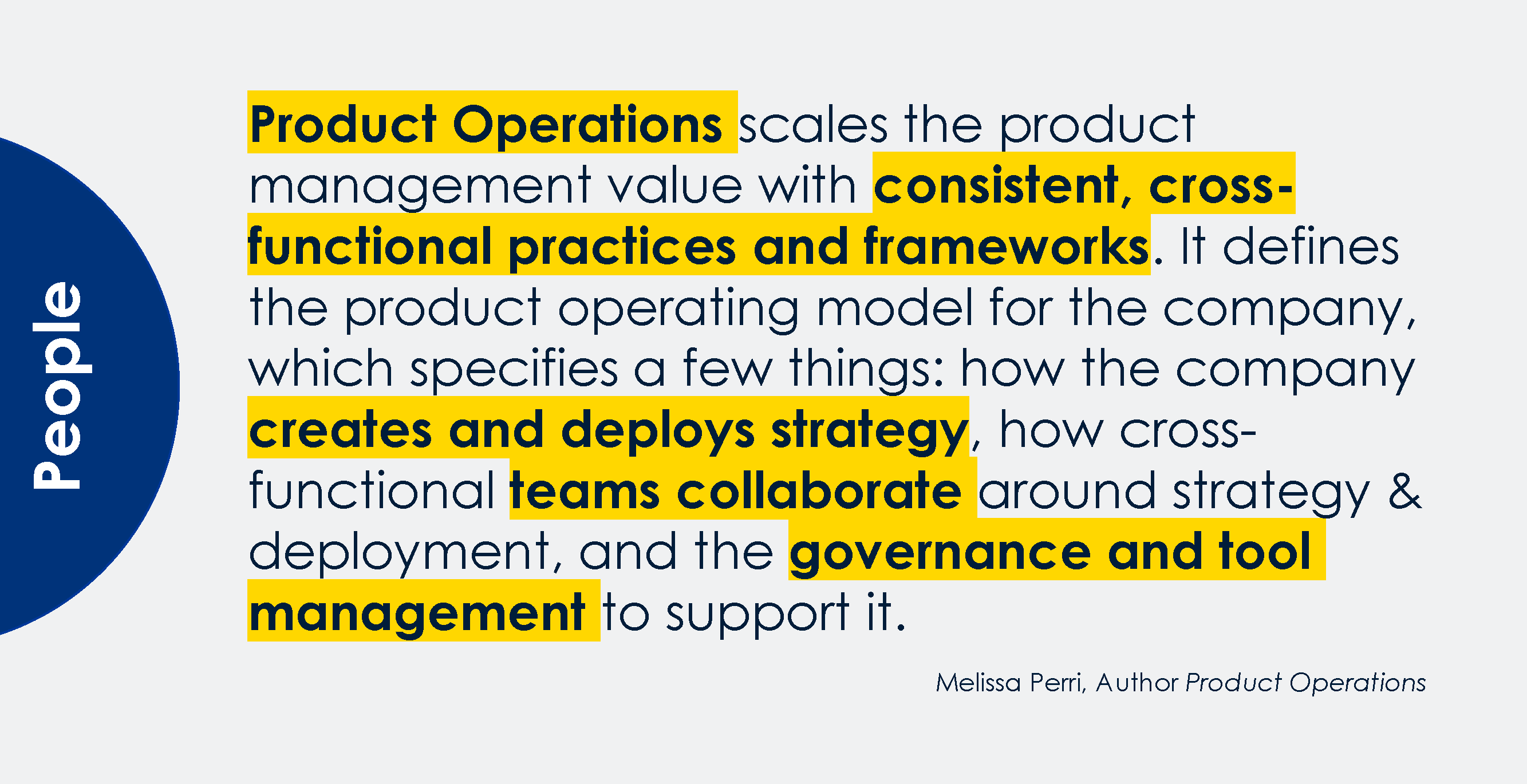
Product Operations scales the product management value was the most critical when talking with our Chief Product Officer and asking, “How do we scale ourselves? How do we create the kind of scale we want?” We create consistent cross-functional practices and frameworks. We are creating and deploying strategies. We are enabling the teams to collaborate and creating the governance and tool management to support all of that. I couldn’t have said it better myself and I was so excited when I read that she had articulated it that way. And that’s really what we’ve ended up building.
“Little did I know all the change management and effort that needed to go into making our program successful, it was way more than just OKRs at the end of the day.”
Within the delivery management scope is a pillar that’s dedicated to our Product Operations... we’ve got this Product Operations pillar. When we first engaged with WorkBoard, I thought, the Product team knew OKRs. We didn’t really need any services, we just needed the license. We’ll get the OKRs in there, we’ll be great. Little did I know all the change management and effort that needed to go into making our program successful, it was way more than just OKRs at the end of the day. So, after about a year, we carved off one full-time associate, then added one more to accelerate and increase the impact that we have. And then obviously with the support of WorkBoard, this group was responsible for these planning processes and overall practices, roles, and responsibilities between our different functions. So, it wasn’t like one leader saying to their team of associates, “These are our OKRs.” It was generating alignment across the function and making sure that we’re all talking about it the same way with those teams about leadership alignment and cross-functional alignment. In our program, and for Product Management, we designated OKR coaches, and now we’re asking the directors in Product Management to really own the OKRs and the quality of the OKRs and the alignment of the strategy, which has been a great evolution of that role delivery management.
We’ve dedicated portions of an individual’s role in each of our three Product groups to bring to life what our Product Operations practices are within each of those product groups. We had a shared mission, if you will, among some smaller population of associates to help spread the mission. Then strategy analysts ended up being more critical than I realized at the beginning because they were phenomenal at understanding the data, the value, and a lot of that in various locations, but being able to really bring that in and tie that back into the OKRs has been really important. We needed to be sure and still continue to need to be sure that they are aligned to what we want to do with our program and have what they need to be able to do so. Their responsibilities are really around the key result targets, making sure we’re setting the appropriate ones for the work that we have planned, and then making sure that those are consistently current with mapping what we’ve done to the outcomes that we wanted.
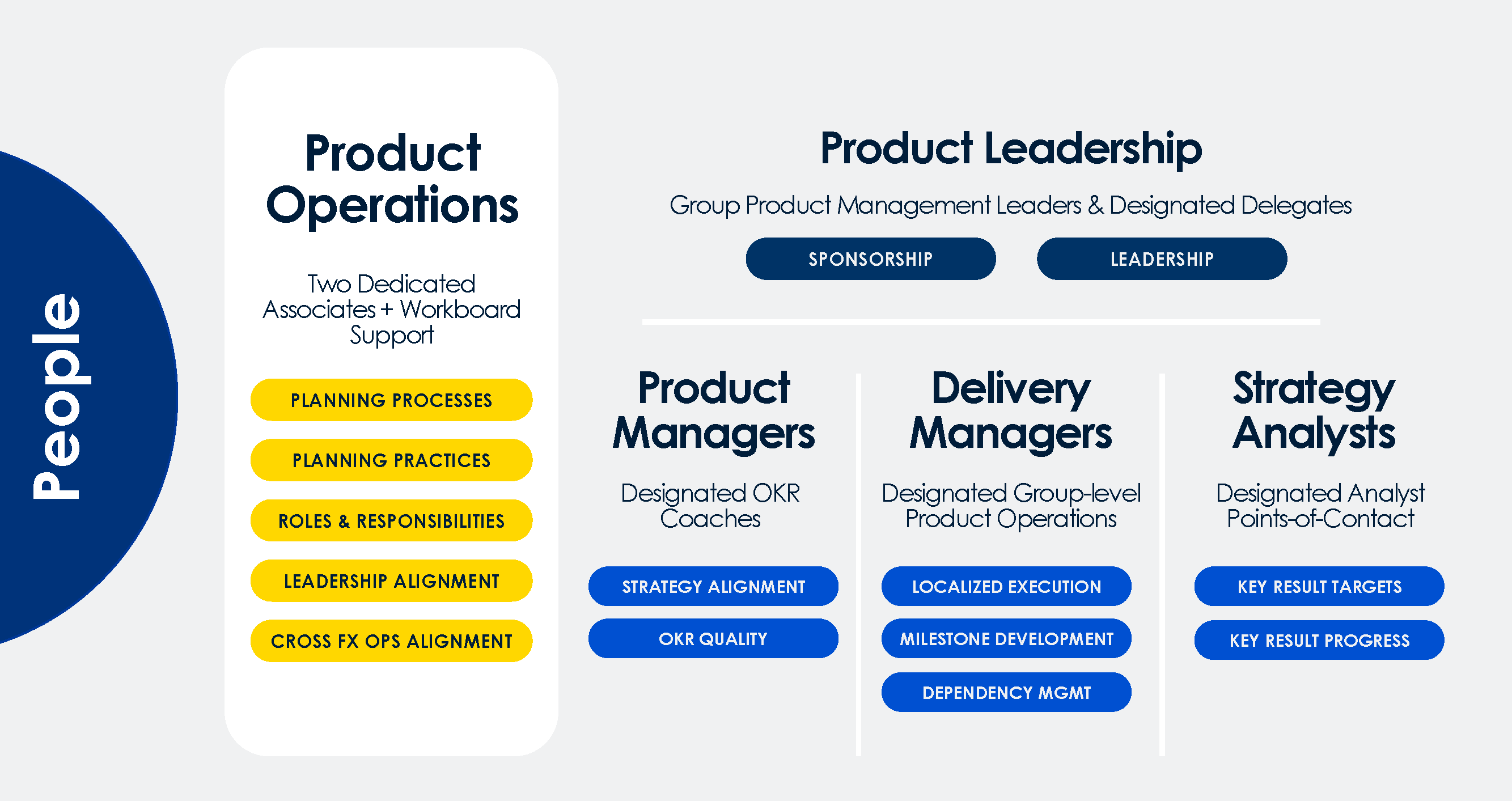
The Setup & Evolution: Process
It feels like we had to do one before the other, but we have made this like a continuous cycle, defining some philosophies for CarMax, instilling discipline around some of these practices, and then finally managing them.
“So, it wasn’t like one leader saying to their team of associates, ‘These are our OKRs.’ It was generating alignment across the function and making sure that we’re all talking about it the same way with those teams about leadership alignment and cross-functional alignment.”
First, around defining philosophies, OKRs meant something to product managers at CarMax to the Product team in general. But we needed to shore up what exactly we meant by that for CarMax. And WorkBoard had a philosophy that was really closely aligned to what Marty Kagan’s philosophy was. But every one of the product managers had a different perspective on what that meant. When we brought together our Product leaders and Product Management leaders, and asked, “What are OKRs? What does good look like for OKRs at CarMax?” we would talk through it, we referenced it a fair amount, and come back to that. And it’s the mechanics in the WorkBoard system that have enabled us to showcase whether they’re meeting our philosophy. And then similarly the milestones were probably the biggest change for our team because there was so much tension. When our Chief Product Officer said, “I just want to hit our OKRs,” what he meant was, “I want to meet our milestones. I want to get the output that I think will drive the outcome.”
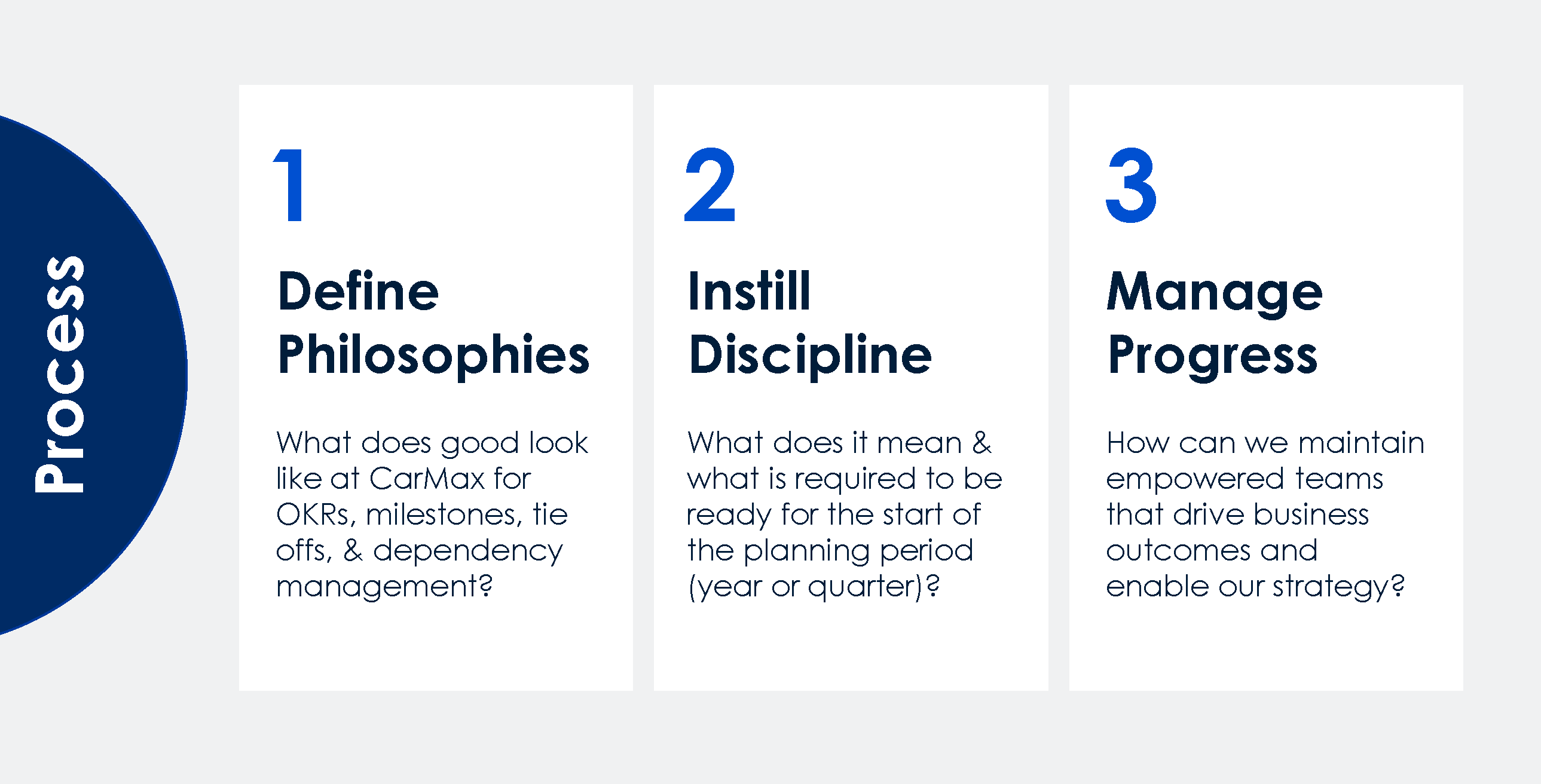
There was strong tension between how we manage and understand what the work is that’s happening in the progress to give me confidence as a leader that we will meet those outcomes. So, I said they’re two different things. One, let’s talk about what those objectives are, what the measures of success are, and then two, let’s also talk about the work we think we’re going do that will drive that. They’ll probably get clearer as we get closer and further along, but let’s still define those as two separate things and two necessary things to be ready for the quarter. Defining these philosophies and the change management around that has ended up being critical to the success of our strategy execution.
“Having one planning calendar in one aligned view on what readiness for the quarter looked like has been so important for our alignment.”
Second was just instilling discipline. We’ve got three Product groups with different leadership teams that are cross-functional. Then the next layer down, we’ve got 15 different programs that ladder into those groups. And then we’ve got 70 teams. And readiness for the quarter looked very different for every one of those groups and every one of those programs and every one of those teams. So, we would get into these instances where this team had already set their OKRs and already decided what their work was for the quarter and had committed to what that was going to look like with their leader, and they aligned. Then another team in a different group had not yet set their OKRs. Once they did, they got to a point of understanding what the work was, then they’d come to that team and say, “Hey, I have a dependency on you.” And that dependent team would say, “Well, I already have my quarter planned out so I can get to that in the next quarter.” Then this team said, “I can’t meet my quarter objectives then.” And this was just pervasive in a lot of different spots, and it was tricky and challenging. So, having one planning calendar in one aligned view on what readiness for the quarter looked like has been so important for our alignment.
We started more aggressive about a year ago in terms of all the meetings that we thought needed to happen in each quarter. We started to actually peel that back as folks have gotten more comfortable with what readiness means and kept the checkpoints along the way where we need to get people together to align. So, it was up to them on how they want to use their time to be aligned as a team, but we’re going to use to align with our program, to align with our groups, and to align with our Product leaders. Our milestones became so important as the kind of full picture of what we needed to be ready for the quarter. We talked about defining each of these things and then tying off on each of these things as something we needed to achieve before the quarter starts.
The third aspect of our process is managing progress: having a management system to manage our Product teams and the holistic picture on managing progress and confidence. It’s more complex than just the OKRs, the milestones, or the team engagement. We have a full picture of what we need to look at together to know if we’re going to meet our objectives. We’ve played around with different ways and tools to be able to do that, but bringing that full picture together and not being surprised when one function says, “Hey, our DevOps metrics are not great on this team.” Or, “The velocity is really suffering on that team went over here.” And someone else said, “Yeah, but we’re meeting our OKRs.” Really seeing the full picture of what that team looks like has been really instrumental.
“We embed the scorecards to enable us to look at what the OKRs are and what the work is that we think is driving those OKRs.”
Setup & Evolution: Technology
The last topic of this section is the technology. Obviously WorkBoard has been helpful from a thought partnership standpoint in bringing this program to life. And the platform itself has been amazing too, enforcing and encouraging the conversations that we need to have happen and having a single source of truth for our progress against it. We have used some different tools within the WorkBoard platform on both planning and management of our teams, but generally for planning, we’ve used the canvas function and we’ve used our running business reviews to tie off on some of our OKRs. And then we use the workstreams and action items for understanding what our milestones are and talking through our dependencies. And then in terms of management, we’ve used a lot of the running business reviews, the agendas, and scorecards to integrate the full picture and be able to understand what is holistically happening and pulling in that management system.
Each action item is a different milestone. Some of them can roll up as we look at a team to program or group. They are a little more detailed, so we need a summary view at the next level. But that has created a lot of visibility for us. WorkBoard was great in helping us think through how we use the existing tools available to be able to manage through that. The discipline we want to have around those milestones. Just like a lot of our teams have discipline on individual cards, like in a work management board on their actual lean kit or Jira boards.
And then in terms of our management, these monthly program reviews, we started them in a Word document but over time we’ve migrated them into WorkBoard. Some of them look a little bit different, and we’ve been okay with that as long as they have the key ingredients that we’re looking for. We’ve generally had an agenda that we embed from the agenda application. Then we have some text fields where we can add some leadership commentary. We embed the scorecards to enable us to look at what the OKRs are and what the work is that we think is driving those OKRs. And then we have some additional reporting that we embed: some Excel templates or in some cases we even have a few slides if we want to visualize what some additional context into health of the team or health of the program is. So that’s really tactical in terms of how we’re leveraging the platform as the backdrop and backbone to what our actual process is. And the system is to plan for the quarter and manage our teams. So, at this point, if you talk to many people, they will say, “We are more aligned than ever.” Which is amazing because two years ago, it felt like chaos to our earlier conversation. I think we have a long way to go but it is so cool to hear people say that it’s a really good feeling.
“At the highest level we have great strategy, but really teaching the fundamentals of what good strategy looks like at every level is that’s hard.”
However, only 47% of our teams have achieved their outcome. Which is a win honestly, to even know that statistic! When I started in this org, we had like a 60-page PowerPoint of every single team scorecard. There was no way we would know this number then. Our goal is to get to 90%, or at least 70%, but we want 90% of the teams to achieve at least 70% of their goal, right? That means they’re pretty well calibrated on what they can do, and they have a pretty good strategy and clarity into what they need to do to build that or to meet that strategy. So, as our Chief Product Officer, Mr. Strategist, said recently, “I really think we have a strategy problem.” Which I think was painful for him to say and I honestly agree. At the highest level we have great strategy, but really teaching the fundamentals of what good strategy looks like at every level is – that’s hard. And it’s something that we need to work towards. One of the biggest things that we’ll be thinking about now and into the year ahead, is how do we really instill discipline around good strategy and enable us to actually make these quarterly planning processes not quite so burdensome. It is a lot of time right now because we don’t have that kind of longer 12- to 18- to 24-month strategy.
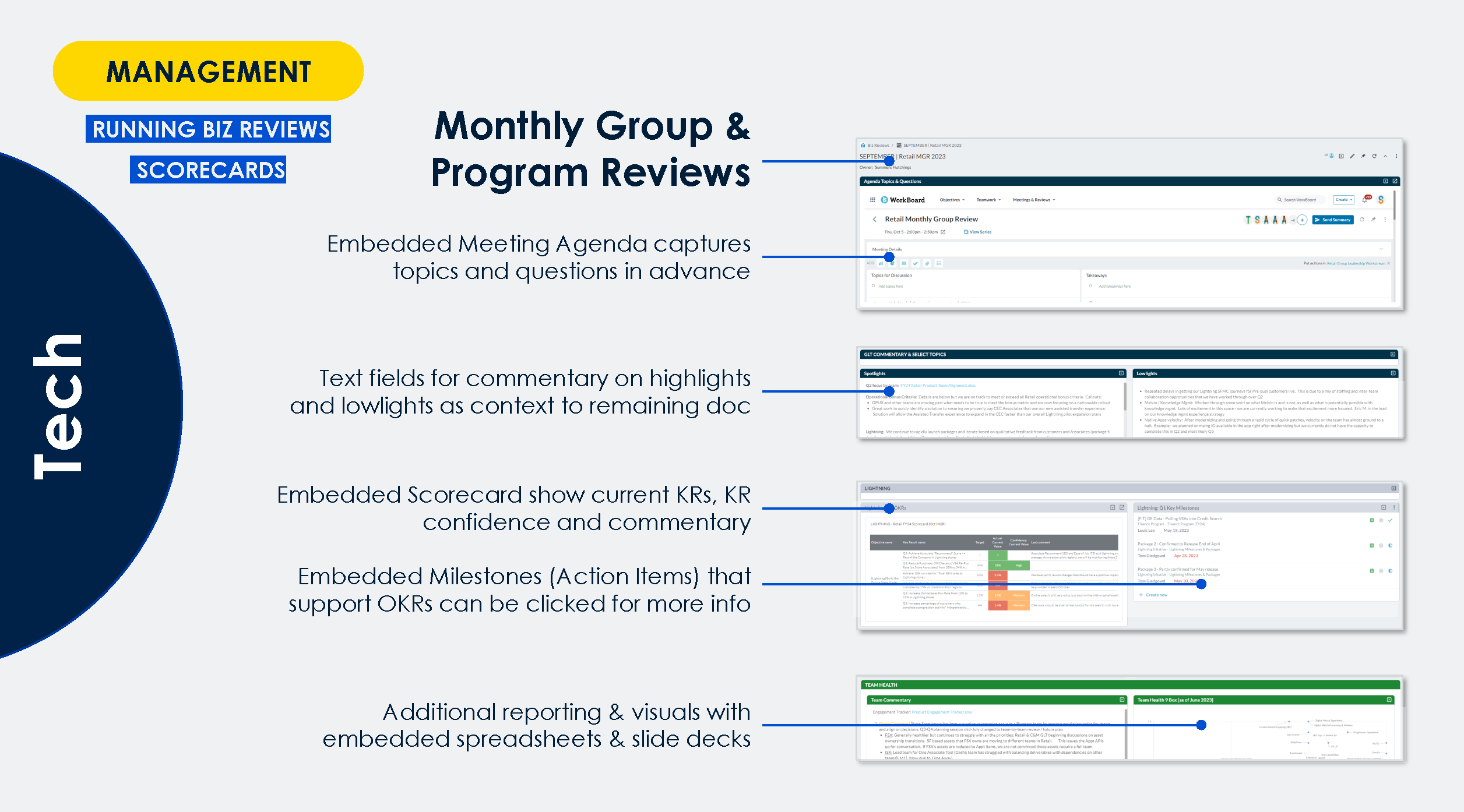
Looking Ahead
Looking ahead, no secret at this point, annual planning in our 12-month strategy discipline, that’s something we’re working through right now. Some of it is as simple as putting together a simple template that everyone is looking towards and understands what the key ingredients are to strategy. It’s not that hard. But sometimes you just must put the thing in front of the person and get them to write it down. That’ll be really important for us. The next is cross-functional planning and cycle alignment. One of the things we’d love to do is to get tighter on our planning cycles and being consistent across our different functions so that we can feel even stronger about our overarching corporate strategy and that our product strategy is even more likely to be achieved. One thing for my team in Delivery has been being more rigorous around what our metrics are to manage the velocity on the teams and understanding where there might be hotspots or areas that are understaffed relative to what our ambition is for that team. There are more nuanced pieces of the puzzle that we want to put some more rigor around. And we’ll be focusing on that in this year ahead.
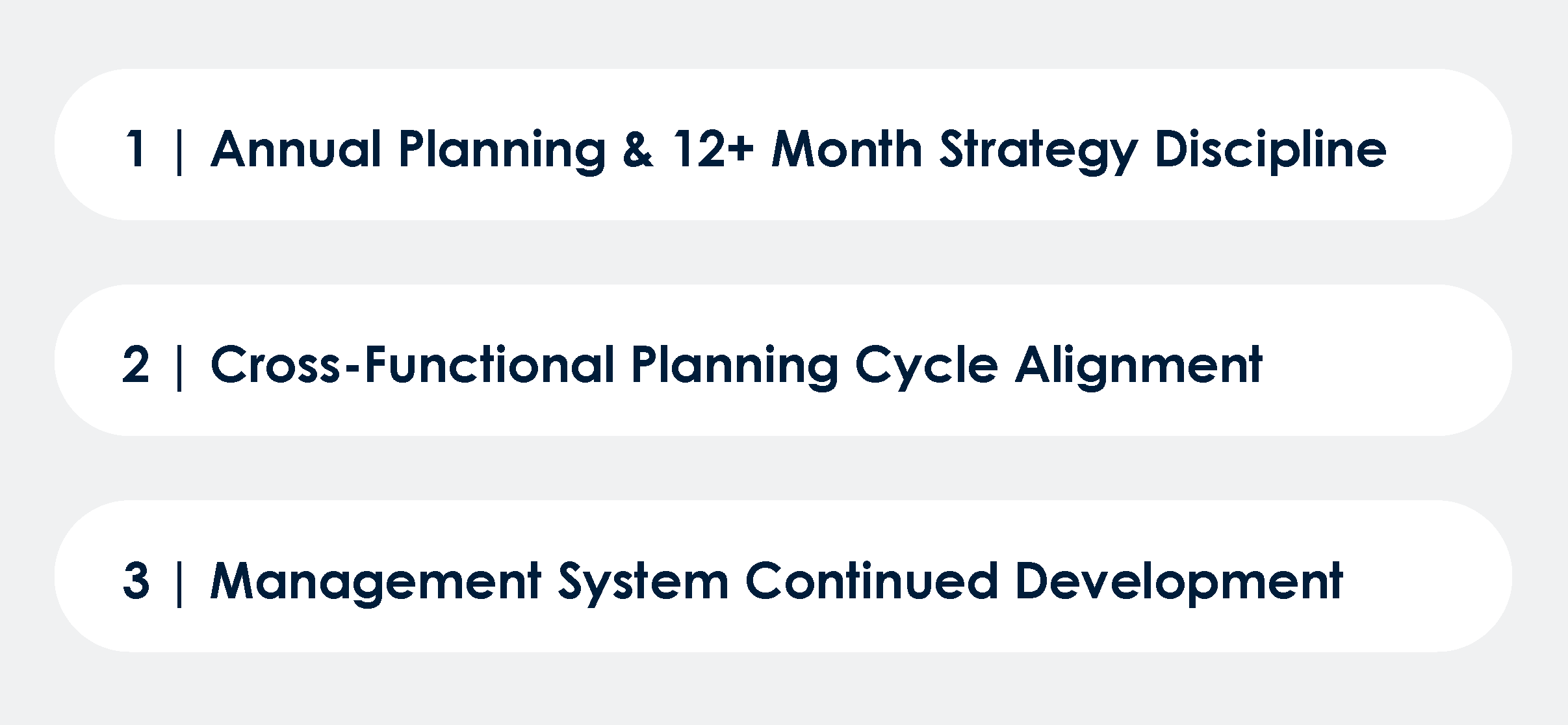
Do’s & Don’ts
Some do’s and don’ts: Certainly, my lesson learned is, don’t underestimate the behavioral shifts. Trying to do this side of the desk was impossible. I failed for sure. As much as I wanted to believe putting a deck together that looked really great and sharing it a few times would work. It didn’t work. In addition to that, find who your advocates are, as in, find the places where the pain is most acute. I started with our now Chief Product Officer saying, “This would be great, it’ll be so cool.” And he said, “It will be so cool, but I don’t manage that way. I don’t like this. This isn’t going to work for me.” But I said, “No, I think we really, really need this.”
So, I met with my peers who are group product leaders, and they were desperately feeling the pain. Their scope was very wide, and they were having a hard time managing, and they were all about having more discipline here, so finding the spots where it was most acute and having those advocates was a tremendous help for me and for our program to be able to implement some of this change. Secondly, it’s so easy to want to just set the process and then forget it. But all the more reason to have someone dedicated to looking at what your organizing principles are, or your operating structure is on an ongoing basis.
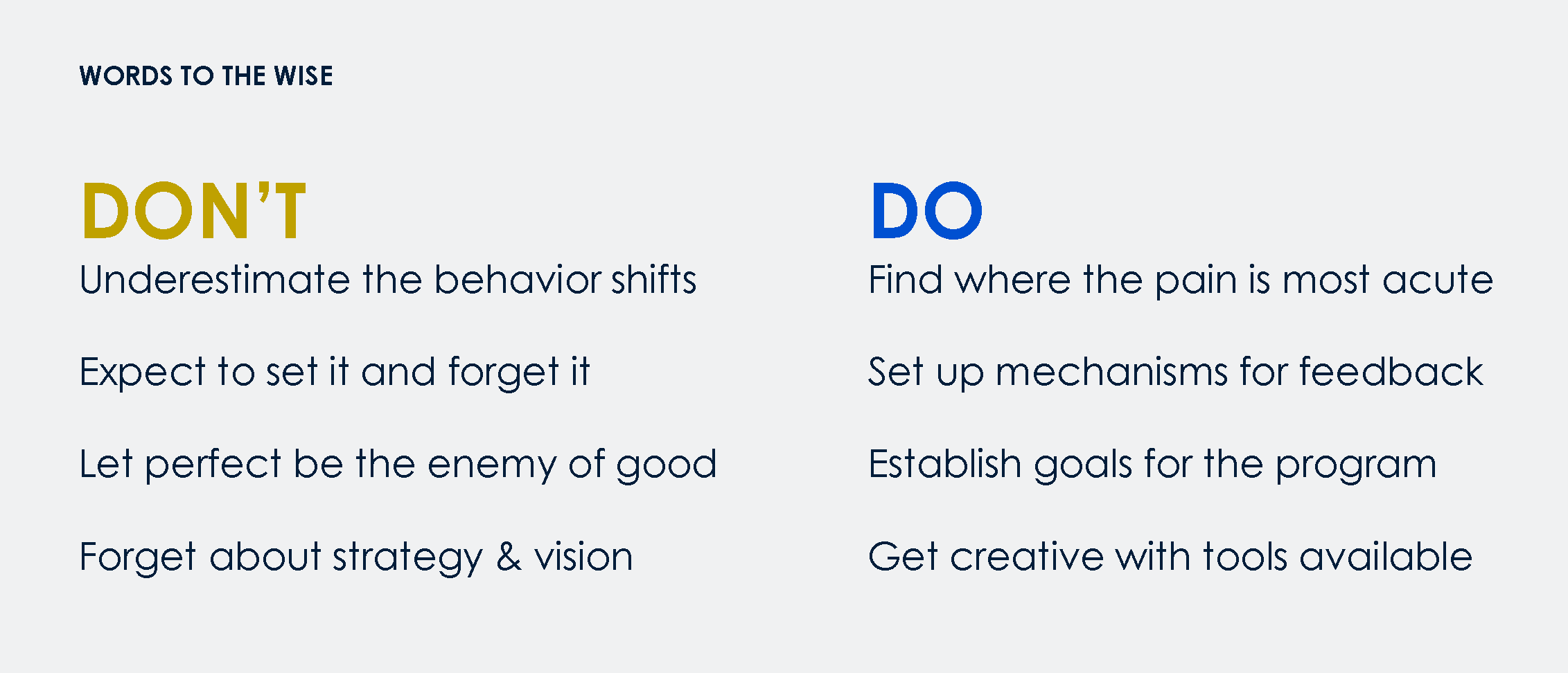
We’ve evolved every quarter, and we have these quarterly feedback mechanisms. So, we selectively pick a handful of people at the team, the program, and the group level each quarter and interview them one-on-one.
And then we have a survey that is also sent out so anyone can give us feedback. And we take that to heart, and we’ve tried to really meet where people are, and still get the outcomes that we want the next time around. Letting perfect be the enemy of good – I’m the most guilty of this, where I would love this to just be some perfect thing that just like runs like a machine, but people are not machines and people shouldn’t be machines. We need something that can really adapt and work towards what good could look like. And it’s okay if it’s not perfect from the start. But being able to establish some goals for ourselves as a program and being able to measure ourselves against that has been huge. It’s helped with our leaders too, to see that we’re getting better. We’re not there yet, but all hope is not lost.
“We need something that can really adapt and work towards what good could look like. And it’s okay if it’s not perfect from the start.”
And then the last is, you can’t forget about the strategy and vision. I feel the tension all the time where if we don’t have a great strategy, executing can be perfect all day long, but we’re not actually going to move the needle on our business, we’re not going to be able to compete with the Carvana’s of the world. And so having that higher order strategy and clarity on what that higher order strategy is has been so important and continues to be important.
We do get creative in the tools that we use to bring that to life. We still build slides, we still have videos, visuals that inspire people. We’ve explored storyboards where we can bring in a journey and talk through with people and help them really internalize what this future experience could look like. There’s a whole suite of tools in addition to WorkBoard that are needed to be successful. And we’ve just had to be really creative about what those tools are available to us and how to leverage those different tools in a way that can help us. So, that’s really our story. I think we have a long journey ahead, but it’s been a phenomenal one thus far and we are really proud of where we are.






